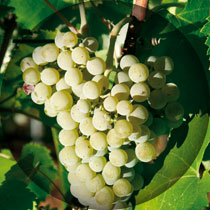Azal (PT)
Variety: white | Category III | Portugal


General Information
Azal


Origin: From the Vinhos Verdes region. Lacerda Lobo (1790) recorded this variety in the sub-regions of Vinhos Verdes in Vizela and Basto.
Chief areas of distribution: Amarante, Basto, Baião, Sousa.
Official synonym(s) (national and OIV): None.
Historic and regional synonyms: Azal da Lixa, Gadelhudo.
Homonym(s): Azal tinto.
Area under cultivation: 3,800 ha.
New plantings: Less than 0.2%.
Trend: Seldom planted.
Varietal variability: Medium.
Availability of propagating material: RNSV polyclonal material available. Certified RNSV clonal material currently being prepared.
Molecular Profile (OIV)
Regional Classification
Morphology
Phenology
Vegetative Potential
Viticultural Parameters
Oenology
Variety Characteristics
| VVMD5 | VVMD7 | VVMD27 | VrZag62 | VrZag79 | VVS2 | ||||||
| Allele1 | Allele2 | Allele1 | Allele2 | Allele1 | Allele2 | Allele1 | Allele2 | Allele1 | Allele2 | Allele1 | Allele2 |
| 226 | 232 | 235 | 243 | 181 | 185 | 194 | 204 | 247 | 251 | 153 | 159 |
DOC quality wine: Sub-regions of Vinhos Verdes, Amarante, Baião, Basto and Sousa.
Regional wine: Minho.
Young shoot (form of tip): Open, prostrate hairs of medium density, medium crimson red tip.
Young leaf: Green with copper spots, medium and dense prostrate hairs on ventral side.
Young shoot: Red stripes, medium anthocyanin colouration of the buds
Inflorescence (sex of flower): Hermaphrodite.
Mature leaf: Of medium size, circular, dark green blade, flat, medium blistering of upper side of blade, dense prostrate hairs and sparse to medium erect hairs on lower side of blade, medium even teeth; closed and slightly open petiolar sinus, sometimes limited by main veins, open V-shaped upper lateral sinuses.
Bunch: Medium to large, medium density, peduncle of medium size.
Berry: Large, elliptic, yellow green, thin skin, flesh of medium firmness.
Time of bud burst: Early, at the same time as the Fernão Pires.
Flowering: Normal, 2 days before the Fernão Pires.
Berry (colour change): Late, 17 days after the Fernão Pires.
Berry (harvest ripe): Normal, one week after the Fernão Pires.
Vigour of shoot growth: High.
Pruning weight:: 1,500 – 2,200 kg/ha.
Shoot attitude (habit): Semi-erect, somewhat plagiotropic.
Length of internodes: Long.
Shoot length: Long, with good lignification.
Tendency to form lateral shoots: High.
Rate of multiple bud bursts: Low.
Bud fertility index: Medium (1.3 flowers per shoot).
Yield: Higher Index (10.000 - 21.000 kg/ha). RNSV statistical values: 4.96 kg/vine (Average of at least 40 clones in Marco de Canavezes over 3 years).
Yield consistency: High.
Crop uniformity: Uniform.
Winkler Index: 1,305.
Sensitivity to abiotic factors: Not yet determined.
Susceptibility to fungal diseases: Susceptible to Peronospora, Oidium and Bunch Rot (Botrytis).
Systemic viral infection prior to selection: 20% GLRaV-3, 10% GFkV, <50% RSPV.
Susceptibility to Pests: Vine leafhopper.
Bunch size: Medium (326 - 373 g).
Bunch density: Dense.
Berry skin: Thick.
Seeds per berry: 2.0.
Vineyard conduction system: Suited to all training systems commonly used in the Vinhos Verdes region, including the Guyot and cordon.
Soil requirement: Quality is achieved only in deep, not too fertile soils, orientated towards the sun.
Climatic requirements: Withstands wind, sun and humidity well.
Vine density: Suited to all vine spacings greater than 1 m apart.
Rootstock: Very compatible with 196-17, P1103, SO4, 420 A, 101-14, 3309 C.
Irrigation: Controlled irrigation, using a tensiometer, is recommended when drought stress occurs.
Incidence of coulure/millerandage: None.
Spoilage of mature berries: None.
Risk of bird damage: No protection required.
Machine harvest suitability: Because of the method of cultivation, soil structure and topography of this variety's region of origin, machine harvest brings no advantages, but it is suitable where modern wire frame trellising systems are used.
Wine type: Vinho Verde (light wine).
Potential alcohol content: 10% vol. RNSV statistical value: 11.35% vol. (Average of at least 40 clones in Amarante over 6 years).
Natural acidity of must: Very high (6 - 8 g/l). RNSV statistical value: 10.43 g/l. (Average of at least 40 clones in Amarante over 6 years).
Risk of oxidation of must: Medium.
Colour intensity of wine: Light citrine. Transparent, weak colouration.
Risk of oxidation of wine: Medium.
Aromatic profile: Fruity aroma.
Ageing Potential: Medium. Wine should be consumed within the year.
Blending recommendation: Trajadura, Arinto, Avesso.
Wine Descriptors: Weak colour, open citrus and fruity aroma which lacks intensity (citrus, green apple). Complex, fine, and pleasant in respect of the citron but the fruit lends a somewhat acid taste to this young wine. In good years, the wine acquires a certain fullness and balance (Mota/Garrido).
Wine quality: Good light wine.
Variety Characteristics: A variety whose production of light wines is restricted to the Vinhos Verdes region, although it could adapt to other regions. Its most striking quality is that of predominant acidity.

